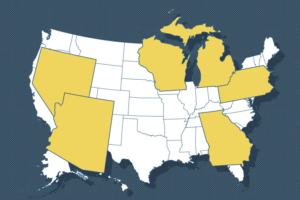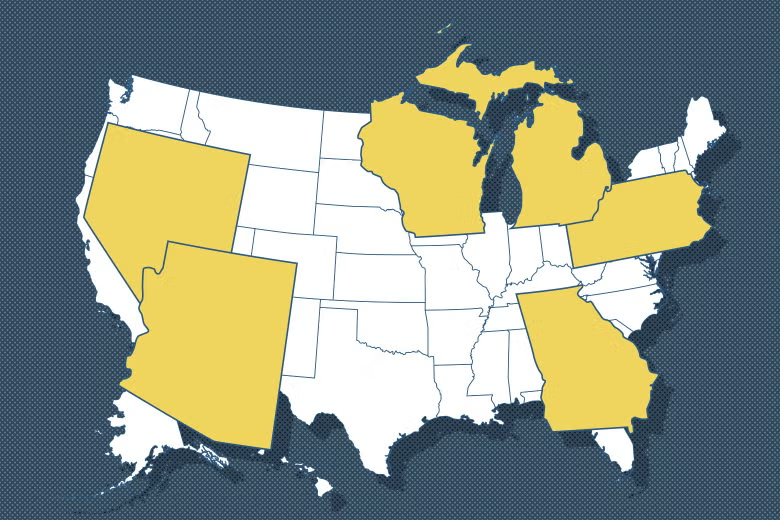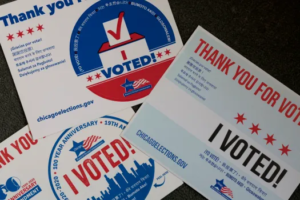In the intricate chessboard of American politics, swing states hold a unique and powerful position. These pivotal battlegrounds, where neither Democrats nor Republicans hold a decisive majority, often determine the outcome of presidential elections. As the 2024 race heats up, all eyes are on states like Pennsylvania, Georgia, Arizona, and Wisconsin—places where every vote truly counts.
This essay explores the historical importance of swing states, examines key factors shaping the 2024 election, and analyzes the strategies candidates are using to secure these critical wins.

The Historical Importance of Swing States
The role of swing states has been central to U.S. presidential politics for decades. In recent elections, they’ve proven to be kingmakers. For example:
- 2016 Election: Donald Trump’s victory was sealed by razor-thin margins in Michigan, Wisconsin, and Pennsylvania.
- 2020 Election: Joe Biden reclaimed the White House by flipping Arizona, Georgia, and Pennsylvania.
These states often reflect the broader national mood, making them a microcosm of American political divides. Swing states are unpredictable, and their voters demand attention, ensuring that candidates tailor their platforms to address local concerns.
The Key Players in 2024
For 2024, the following swing states are in the spotlight:
- Pennsylvania: Often called the “Keystone State,” Pennsylvania is a bellwether for blue-collar workers and suburban moderates. Its 19 electoral votes are critical for any path to victory. Key issues here include job creation, energy policy, and healthcare.
- Georgia: Once a Republican stronghold, Georgia flipped blue in 2020, thanks to increased voter turnout among African Americans and suburban women. Abortion rights and voting access are expected to dominate the debate in 2024.
- Arizona: This state has seen rapid demographic changes, with growing Latino and suburban populations. Immigration policy, water rights, and education are top concerns.
- Wisconsin: With its mix of urban liberal centers and rural conservative areas, Wisconsin epitomizes the swing state dynamic. Healthcare and manufacturing jobs are high on voters’ agendas.
Demographics: The Driving Force Behind Swing State Politics
Demographic shifts are reshaping the political landscape in these states. Factors like age, race, and education level significantly influence voter behavior:
- Young Voters: Millennials and Gen Z are becoming a larger share of the electorate. These groups prioritize climate change, student debt relief, and gun control.
- Suburban Women: Often decisive in swing states, this group has shown heightened concern over abortion rights following the Supreme Court’s Dobbs decision.
- Latino Voters: In states like Arizona and Nevada, Latino communities are a growing electoral force, with immigration and economic opportunity as key issues.
Candidate Strategies for 2024
Winning a swing state requires more than just broad national appeal; candidates must speak directly to local issues. Here’s how both major parties are strategizing:
- Republican Strategy: Republicans are focusing on economic concerns, crime, and school choice. They aim to energize rural voters and working-class Americans while making inroads with suburban families.
- Democratic Strategy: Democrats are prioritizing abortion rights, healthcare, and climate change. They are doubling down on voter outreach in urban centers and targeting communities of color.
Both parties are also leveraging technology, using data analytics to micro-target voters with tailored messages via social media and text campaigns.
The Role of Grassroots Movements
Grassroots activism has become a cornerstone of swing state politics. In Georgia, for instance, organizations like Fair Fight Action, founded by Stacey Abrams, played a key role in increasing voter turnout in 2020. Similarly, Wisconsin’s local unions and advocacy groups are mobilizing voters around issues like labor rights and education.
These efforts highlight the power of community-driven politics, where local voices often hold more sway than high-budget ad campaigns.
Challenges and Controversies
Swing states are often ground zero for political controversies, including:
- Election Integrity: Allegations of voter fraud and restrictive voting laws have sparked debates over election security and access.
- Misinformation: With the rise of social media, swing state voters are bombarded with both accurate information and false narratives, complicating their decision-making process.
- Polarization: In many swing states, ideological divides between urban and rural areas are deepening, making it harder to find common ground.
Why Swing States Matter More Than Ever
The stakes in 2024 are particularly high, with issues like climate change, reproductive rights, and the economy on the line. Swing states not only determine the next president but also reflect the nation’s broader divisions and aspirations.
As campaign ads flood the airwaves and candidates crisscross the country, it’s clear that Pennsylvania, Georgia, Arizona, and Wisconsin will once again hold the key to the White House.
In the end, the power of democracy lies in the hands of these pivotal voters. As the nation watches, the choices made in these swing states will shape the course of American history for years to come.

